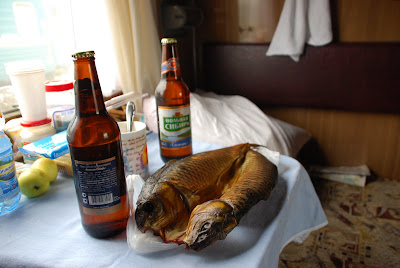Foreigners in
Russia almost always note one peculiarity about Russians’ travelling habits – Russkis take food, home-made food, pretty much wherever they go.
 Inside a Russian train (a more luxury version). Photo thanks to Tatters:) at farm3.static.flickr
Inside a Russian train (a more luxury version). Photo thanks to Tatters:) at farm3.static.flickr
Trains in particular are a sight of numerous feasts. Soviet trains are of course like nothing else in the world – almost double the width of their European compatriots, snail-speed slow but wonderfully public (which may or may not be to your liking - ‘platzkart’ being the most common type of a carriage – no doors, just 6 bunks of beds in each row and a little table in between. I remember long strands of white sheets hanging off the top beds as if to make a little self-made alcove, to allow women to change clothes. It all seemed so much fun then…not because of changing women of course...although this might have been fun now..hmm, sorry, back to trains).

Food in Russian trains. Photo thanks to streats.files.wordpress
A common scene encountered on those long, clickety train journeys would be families, babushkas, young ladies – all taking out their carefully wrapped goody bags, laying them out on tables in between the rows of bunk beds, sharing these ‘products’ with their fellow compartment comrades. These offerings, which could include anything from stacks of buterbrody (open sandwiches) to home-pickled gherkins and full blown hot meals, always had to have some hard-boiled eggs. I still remember their very characteristic smell whifting through the carriages, the sound of spoons clattering in tall glasses with dark tea, quiet cluckering of women over their offspring…
Recently I have re-created – ish – these childhood memories on my way from London to Tallinn, Estonia – the motherland, as I sometimes refer to it. This was the kind of upgraded version of the old Russian train-food experience:
Location – Stansted airport, waiting lounge
People – common human crowd all around, a good – Russian – friend next shoulder
Food – Chilled ox tongue (home-made), gherkins, rye bread (Waitrosely good), forgettebly named Russian chocolate
Drink – ex-yoghurt 100ml* plastic bottles filled with red wine and half and half wine and vodka

Feasting at Stansted airport, London a la russe
We had a blast. Gorging on all this beautiful – rather odorous – food right in the middle of, basically, a massive shopping meal, brightly lit as a hospital, it was especially enjoyable because of all the misunderstanding looks grazing, oops, glancing at us. The smell of garlic, which the tongue was packed with, and alcohol, followed by the sounds of cucumbers plopping in our mouths and us talking increasingly loudly, made – I’m sure – for an amusing and rather annoying sight.
Bring on the socialist order (a Conservative-Communist coalition anyone?)! These people have not tried the real publico-social method of travelling – or eating.
….
If you would like to simulate (it can be just that of course – the real thing is at least 3 hours flight away, and some 20 years ago perhaps), then here’s the recipe for the Ox Tongue that we have so successfully consumed amongst the capitalist consumerism of the London airport:
Cooked Ox Tongue

Cooked ox tongue, post ice-water treatment
1 ox tongue (they usually weight about 700-1000 gramms)
garlic liberally
bayleaves + peppercorns
1. They look huge, scary and unpleasant - hold the disbelief. Put in a large saucepan, cover with cold water. Once start boiling, take off the scum (but don't bother too much), then add a couple of bay leaves and 5-10 peppercorns.
2. Simmer for 1.5-2 hours
3. Prepare a large bowl full of ice and cold water. Plunge the cooked tongue into water and keep it there for a couple of minutes.
4. Take out and peel off the outer skin. You'll see, it comes off like a banana skin. The tongue will instantly look that much more appealing.
5. Cool a bit more if necessary, so that you can handle it with hands. In the meantime, slice thinly 2-3 gloves of garlic.
6. Make short, shallow cuts randomly across the tongue, so that you can insert slivers of garlic into these holes. Don't matter, how and when, just pack'em up!
7. Place the tongue onto a flat-ish plate, find something heavy to press it with. I normally put another plate on top, to cover the tongue, and then a saucepan full of water - some careful balancing is required.
8. Chill in a fridge over night.
9. When taken out, the tongue will be flat and ready to be gorged on. Slice it thinly, add horseradish, pickled, bread, and vodka, of course, and you are ready to go.
Train or no train.
* for those far from
London - bigger containers are not allowed to bring into British airports for ‘security reasons’.





